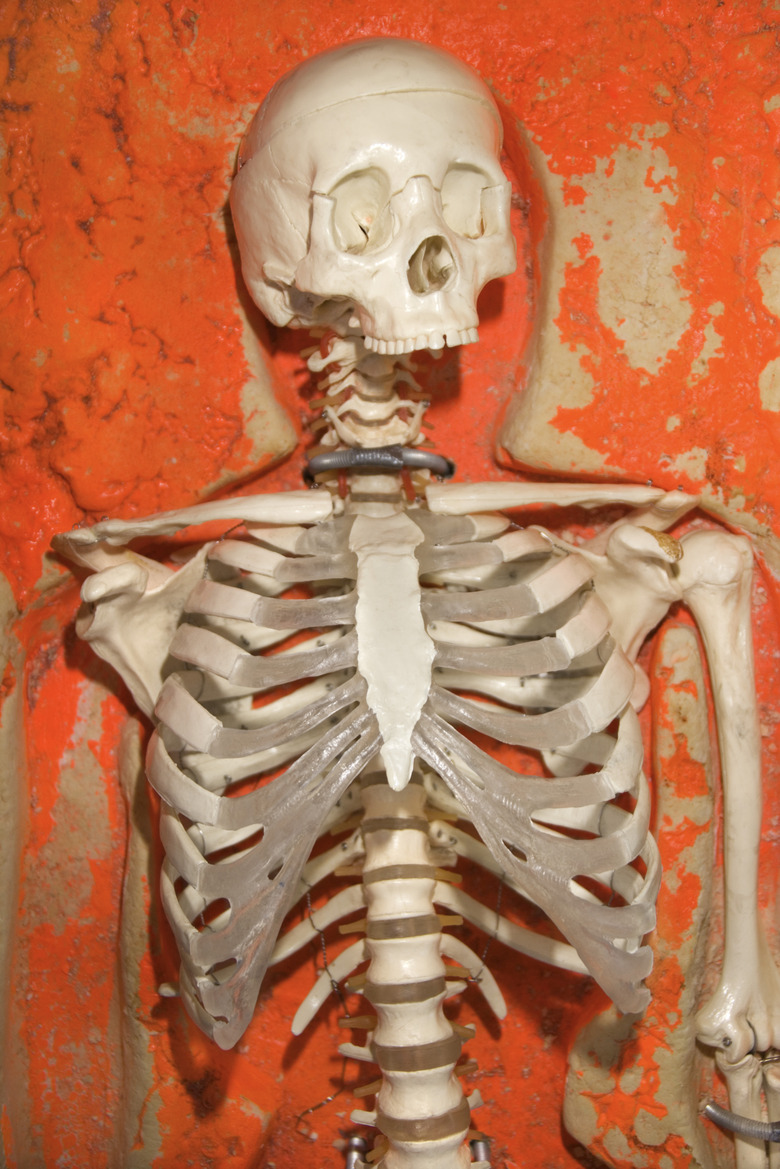What Percentage Of Bones In The Body Comprise The Axial Skeleton?
Without the support of a skeleton, imagine what the human body would look like. The bones of the head and trunk — called the axial skeleton — are especially important. They form the central line, or axis, to which limbs attach and around which organs are distributed. The axial skeleton contains 80 of the human skeleton's 206 bones, accounting for about 39 percent of all bones in the body.
Skull Pieces
Skull Pieces
Bones offer not only support but protection, and the bones seated at the top of the axial skeleton forming the skull are no exception. The skull includes two groups of larger bones — the eight cranial bones, which cradle the brain, and the 14 facial bones, which guard the openings to the respiratory and digestive systems. The three small auditory ossicles in each ear — the malleus, incus and stapes — bring the total number of bones in the skull to 28, which accounts for a little less than 14 percent of the body's bones.
The Floating Bone
The Floating Bone
Below the skull sits one bone that, like the auditory ossicles, is small and easy to overlook. The hyoid is found in the neck near the top of the larynx, where it helps anchor facial muscles. Because it is only one bone, it constitutes less than one percent of the human skeleton, but it is truly unique. Suspended by ligaments, it is the only bone in the body that does not touch another bone.
Crucial Column
Crucial Column
Descending from the skull are the 26 bones of the spinal, or vertebral, column. Anatomy texts separate the 24 actual vertebrae into the seven cervical vertebrae of the neck, the 12 thoracic vertebrae in the chest and the five large lumbar vertebrae of the abdomen. The other two bones, the sacrum and the coccyx, result from small vertebrae fusing together throughout childhood and adolescence. The entire spinal column composes almost 13 percent of the skeleton.
In the Rib Cage
In the Rib Cage
The rib cage reaches around from the spine to enclose the chest organs and includes not only 12 pairs of ribs, but the sternum, or breastbone. Every rib connects to a vertebra; the seven pairs that also directly touch the sternum are called true ribs. Three pairs of false ribs connect indirectly to the sternum via cartilage, while two pairs of floating ribs remain unconnected in front. The rib cage comprises about 12 percent of the body's bones.
References
- National Cancer Institute: Divisions of the Skeleton
- Fundamentals of Anatomy and Physiology, Sixth Edition; Frederic H. Martini
- Georgia State University: The Ossicles
- University of Wisconsin La Crosse: The Hyoid Bone
- Virginia Commonwealth University: The Thoracic Cage/ Respiration & Breathing
Cite This Article
MLA
Johnson, Sheila. "What Percentage Of Bones In The Body Comprise The Axial Skeleton?" sciencing.com, https://www.sciencing.com/what-percentage-of-bones-in-the-body-comprise-the-axial-skeleton-12761249/. 2 February 2014.
APA
Johnson, Sheila. (2014, February 2). What Percentage Of Bones In The Body Comprise The Axial Skeleton?. sciencing.com. Retrieved from https://www.sciencing.com/what-percentage-of-bones-in-the-body-comprise-the-axial-skeleton-12761249/
Chicago
Johnson, Sheila. What Percentage Of Bones In The Body Comprise The Axial Skeleton? last modified March 24, 2022. https://www.sciencing.com/what-percentage-of-bones-in-the-body-comprise-the-axial-skeleton-12761249/
